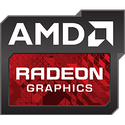Saturday, August 23rd 2014

Radeon R9 285 3DMark FireStrike Performance Revealed
AMD put out its own 3DMark FireStrike performance numbers for its soon-to-launch Radeon R9 285 performance-segment graphics card. Running on a test-bed powered by a Core i7-4960X six-core processor and 16 GB of DDR3-1866 memory, the R9 285 scored P7066 (performance preset) and X3513 (extreme preset); compared to an NVIDIA GeForce GTX 760 (337.88 WHQL driver) scoring P5650 and X2774, on the same test-bed. For a card that's in the same price-range (the R9 285 will start at $249) as the GTX 760 (currently going for as low as $239), that's an impressive performance uplift. The R9 285 will start selling on the 2nd of September, 2014.

21 Comments on Radeon R9 285 3DMark FireStrike Performance Revealed
not that bad, aroud the same perfomance as an overclocked r9 280
People who are concerned with that level of efficiency aren't concerned with 20 more watts, but it is supposed to use significantly less power yes.
At 190w for 3.3Tflops the 285 is on par with the 750ti at its 1.3Tflops.
Scaling efficency up to that big of a die is nice. Curious what the DP performance is.
I want this for Distributed computing if it has good DP.
Seems odd
Given than we can expect the 285 to be 1.6 faster than a TI 750 @ 1080p
Extrapolating the gaming power consumption of the 285 from the 270X (quoted 180W but ingame use peaking around 122) I would expect the 285 to peak around 130W
That would translate as "85% as efficient" (/ TI 750)
Now how does GPU efficiency scale ? While we expect MAXWELL GPU to be power efficient does the power efficiency scale in a linear manner ? In other word should we expect the bigger Maxwell be as efficient as the smaller parts? It was my understanding that with bigger chips (of the same kind) efficiency decrease.
Nvidia had Fermi and after that slowly improved. In the Fermi days AMD slagged NV off for it's power and heat signature. With R9 series it's odd how power efficiency becomes an out of fashion metric. Now Maxwell looks to bring it right back on track, AMD have released Tonga to provide GTX 670 (sorry, GTX 760) beating performance at better than Hawaii efficiencies.
And now AMD energy efficiency is important again. Colour me unimpressed. Not by AMD but by reactions to the 285.
I want to see the real power of Tonga. Not a (potentially) gimped down sales niche product. AMD are toying with their product stack methinks (fair enough I say) but what lurks in the Tonga architecture, beyond that which they are releasing now?
Hawaii was a new die, and both companies are yet unable to move to new processes like they both want, so a overbuilt chip like the 750Ti, that underperforms just shows that anyone can make a chip more power efficient by clocking it down. how about the performance per dollar, and relative performance it can't really do 1080, but for the same price you can get 26% more performance and 34% more power draw both in average (almost linear in performance to power.....strange....) from a HD7870/270/265. Plus the overclocking potential for a 7870 is magnitudes better, so it will last you longer with the same supported DX features.
BF4 runs well, DX11 or Mantle handle Ultra without drops, BF3 low fps on 64 servers.
This is my primary PC ( www.3dmark.com/fs/2257954 ), it runs well too and has margin to OC more.
So, all good...exept for mkv compression, because I can't find a decent OpenCL utility.